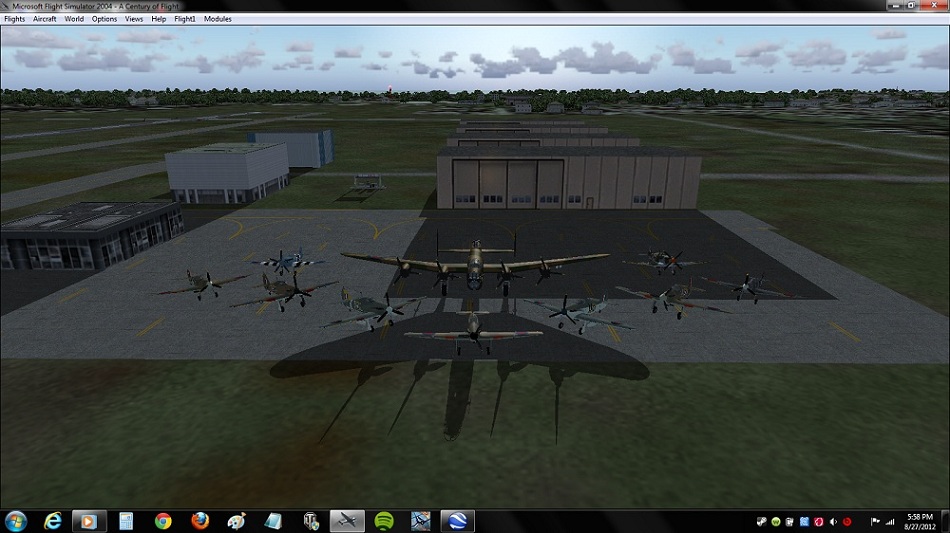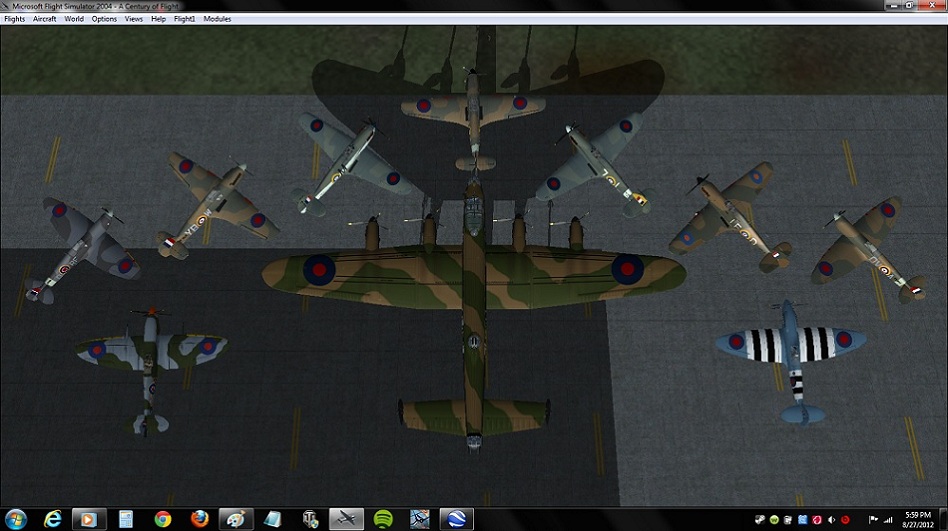Finally getting to the Spitfire's trusty stablemate: the Hurricane. The Hawker Hurricane is certainly not as graceful as the Spitfire nor does it come close to matching the Spitfire in performance....so then why is it worth remembering?
For starters, the Hurricane destroyed more Luftwaffe attackers in the Battle of Britain than ALL other defenses COMBINED! When a He111 or Ju88 crewmen checked their 6, chances are it was a Hurricane bearing down on them.
Like the Spit, the Hurricane is powered by the spectacular Rolls Royce Merline V12 inline liquid cooled engine. Thus a Hurricane has that soothing (too me anyways) purr of the Spitfire and other Merlin powered birds. But what is really noteworthy about the design is its construction: the aft section of the fuselage being fabric covered with the fore and wings aluminum sheeting covered. This is a sign of the time in which the Hurricane was designed.
Originally, the Hurricane was called the 'Fury Monoplane' as it was supposed to be a revised Fury. This biplane fighter to me was the most graceful of the British inter-war period combat planes and was a solid performer. In fact, a few Furies would fight valiantly against the Bf-109 during the Lowlands Campaign of 1940. Thus with such a solid design, Hawker set about molding the Hurricane in the mid to late 30s. First the new Goshawk engine (remember the Type 224?) then retracting main gear, an enclosed canopy, single wing layout, finally 8 .303 machine guns were put in the wings...the end result: a very "workman like" fighter!
With its wider gears, higher chamber wing, and cheaper construction compared to the Spitfire, the Hurricane was far more numerous. Not only that, but it also was deployed on ALL fronts at the start of the war; In the Med, Lowlands, Balkans, South-East Asia, even in Russia! At the opening of hostilities, the Spitfire was still in limited numbers and the best French fighter, the Dewotine D520 was also limited. Thus the Hurricane was the most numerous fighter that could stand against the Bf-109 in the West and usually it was the best fighter to face the Japs as well in the beginning.
A note on Hurricane variants:
The first fighters to provide escort for Atlantic convoys against the marauding Fw-200s was in fact catapult launched Hurricanes. These were known as 'CAT fighters' and were last-ditch measures as the Hurri would have to ditch after its sortie. This did however push the Royal Navy to adopt Sea Hurricanes which were Hurricanes modified for use on regular carriers. These would prove to be thee first 'modern' fighters the Royal Navy could deploy on its carriers (the previous being the Sea Gladiator). In this guise, the Sea Hurricanes gained notoriety for the defense of Malta along with dwindling numbers of Sea Gladiators and growing numbers of Seafires.
In Africa, specially modified Hurricanes sporting 2 40mm cannons under the wings became known as "Flying can-openers" for their disturbing effectiveness against the Africa Corps' panzers.
In the Far-East, Hurricanes were the premier commonwealth fighter in the beginning but were in limited numbers. Still, they conducted just about every combat mission possible. Some examples had 12 (yes that is TWELVE) .303s in the wings! These also had a bomb station under each wing for use in the fighter-bomber role.
The final variant I will single out, is the IIC with 4 20mm cannons. These would prove to be the last variants seeing front-line action in the Western-European theater conduction fighter-bomber raids on targets in Occupied Northern France and the Lowlands up into ~'43 tapering off sharply as US involvement stepped up.
Unfortunately the Hurricane was rather quickly outmatched in the air-to-air role as it was originally designed. Its thick wings and heavily framed canopy were draggy and clumsy in a dogfight. So it stuck around still due to its rugged construction, lower cost, lower maintenance requirements, and more gentle flight characteristics than the Spitfire. Its fabric tail proved to be a very useful feature in combat as enemy High-Explosive rounds would usually just zip right through without detonating..had it been sheet metal covering like the Spit, the rounds would detonate and devastate the structure. Also, the wide gear prevented many of the landing/taxi/takeoff accidents that occurred with Spitfire's do to their narrow gear.
I should note to that the Canadians were rather fond of the Hurricane, producing a large number of several variants. Most Hurricanes left today are in fact Canadian built (at least in the US).
So, now for some links...
http://www.aviation-history.com/hawker/hurrcane.htmlIts predecessor:
http://www.aviation-history.com/hawker/fury.htmlCAT Fighters and their mother ships called 'CAM ships':
http://en.wikipedia.org/wiki/CAM_shipA restored 4 20mm armed 'Flying Tin opener':
http://www.vintagewings.ca/Aircraft/tabid/66/articleType/ArticleView/articleId/1...Some amusing pictures of a nice model of a twin 40mm armed example:
http://cs.finescale.com/fsm/modeling_subjects/f/2/t/75422.aspxHurricane's for various sims
http://simviation.com/1/search?submit=1&keywords=hawker+hurricane&categoryId=&pa...I have the Sea Hurricane package and the MkII packages for FS2004. They are superb packages with very well done virtual cockpits, wonderful exteriors, very nice flight dynamics, but lack a bit in volume on the engine sounds.
In closing, I have to post 2 pictures of my British Merlin aircraft fleet:


The Lancaster is from the Wings of Power addon pack and yes it is an amazing one with sounds that make me giddy just thinki------sorry, got distracted

The Spitfires shown are a collection of some Aeroplane Heaven examples and ALPHAsim freeware planes. Except for the AH Seafires, all are acceptable considering they are FREE, but look at my article on the Spitfire about those..
So there you have it folks, a Hurricane we all would be fortunate to have fly over head..for those experiencing the gulf hurricane, good luck and stay dry!
For the rest, I highly recommend finding a Hurricane near you...just one of the Hawker kind

As always,
I wish you tailwinds and clear skies!
Adam

